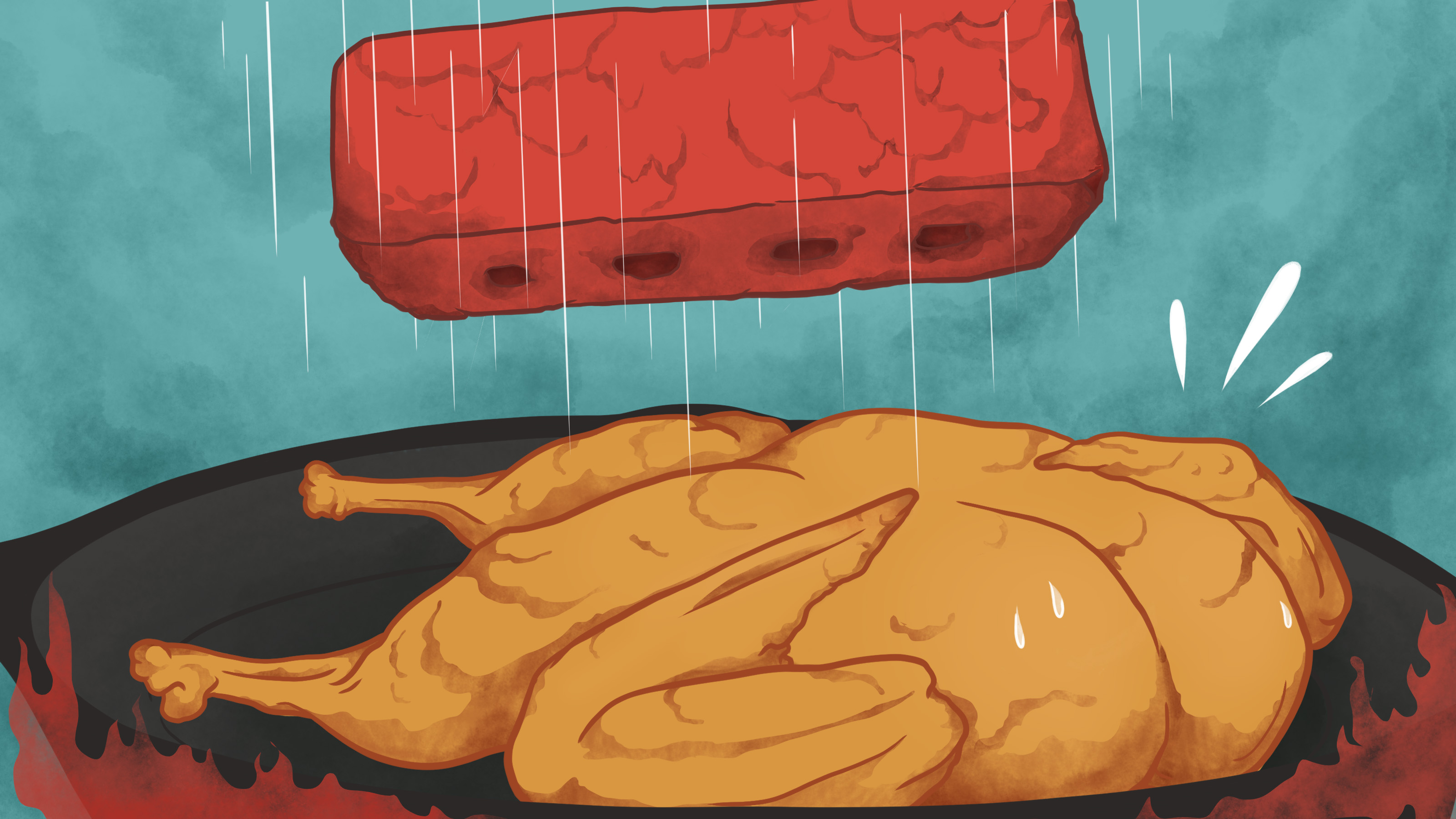For The Crispiest Roast Chicken, Use A Brick And It'll Be Browning Slowly
The venerable roast chicken tests the mettle of the home cook. It's one of the first dish a neophyte cook conquers to graduate into culinary level 202.
In the decade I've been roasting chickens, I've arrived at four epiphanies.
I used to just season the chicken with salt, pepper, olive oil, and throw it in the oven and let the cooking gods take care of the rest. My first epiphany was shellacking the bird with a stick of soft butter and chopped herbs, which I learned from Hugh Fearnly-Whittingstall's The River Cottage Meat Cookbook, my all-time favorite cookbook.
My second epiphany came after I tasted the famed roast chicken from Zuni Cafe in San Francisco. The late chef Judy Rodgers discovered that by seasoning the chicken with salt 48 hours before roasting, the flavor of the meat improves and stays moist throughout.
My third epiphany was learning about spatchcocking—cutting out the spine of the chicken and butterflying the bird open, which cuts the cooking time by 15 minutes.
Several weeks ago, the fourth epiphany came. I'm a believer that one never stops learning in life, but I'm fairly certain this, now, is my ultimate way of roasting chicken.
It involves the time-tested but under-appreciated method of cooking a chicken under a brick. You take a brick, wrap it in tin foil, and place on top of a butterflied chicken, then roast it. What does this do? It flattens the bird into nearly hand-held thickness, retains moisture and speeds up cooking, and most importantly, creates the crispiest and most golden skin I've ever had in a home-cooked roast chicken. I say this with no hyperbole: It's the best dang roast chicken I've made yet.

A few cooking notes:
- I don't actually use a brick. You don't need to. I use a 3.5-quart Le Creuset Dutch oven and plopped it over the chicken with foil in between. It's heavier, and covers a larger surface area than a brick.
- Many recipes call for carefully boning the chicken whole, but I don't have the patience. I'll go as far as snipping the backbone off with kitchen shears. I do employ a helpful tip from chef Marc Forgione, the country's foremost proponent of brick chicken: Because the skin is in extended contact with the hot cooking surface, he only seasons the chicken with salt, as black pepper and herbs will burn.
- Because the skin gets rendered down, it'll release a lot of fat. You are legally obligated to take advantage of this and make a lemon-butter-white wine pan sauce.

“Brick” Roast Chicken
- The smallest whole chicken you can find, ideally 3 1/2 pounds or less
- Salt and pepper
- Canola oil
- 1 lemon
- 1 small shallot
- 1 cup chicken stock
- 1/4 cup dry white wine
- 2 Tbsp. butter
Ask your kindly neighborhood butcher to spatchcock your chicken. Alternatively, take sharp kitchen shears and cut out the backbone on either side. Flatten your chicken, pressing down to crack the breast bone.
If you can, liberally salt your chicken (but not pepper) at least a day, ideally two days before, and let chill in fridge. This makes a world of difference. Otherwise, salt your butterflied chicken at least an hour before roasting. Preheat your oven to 450 degrees.
Use a large cast iron skillet or stainless steel pan, one that would fit the whole bird. Turn on heat to medium-high and coat your pan with canola oil. Pat the chicken skin dry. When the oil shimmers, carefully place your flattened chicken skin-side down. Transfer the pan with the chicken into your heated oven. Top the chicken with a folded-over piece of foil, then place a Dutch oven (or two foil-wrapped bricks) on top.
While this is roasting, we'll prepare for the pan sauce. Mince a whole shallot. Cut a lemon in two—half you'll use for the sauce, the other to squeeze atop the cooked chicken. Have a whisk ready.
After 20 minutes of roasting, very carefully remove the hot Dutch oven and foil cover. Then remove the pan with chicken and place on your stovetop. Using tongs and a firm grip, flip the chicken, ideally without tearing the skin. Place this pan and the chicken back in the oven and roast for 10-12 more minutes. Afterward, you're looking for an internal temperature near the thigh meat of 165 degrees Fahrenheit. Transfer the cooked chicken onto a baking sheet to let rest, as you move onto the pan sauce.
Place the pan—with all the chicken juices and browned bits—on the stovetop and turn the heat to medium-high. Add the minced shallot, and using a wooden spoon, scrape the crusty bits from pan and incorporate with the shallots. When the shallots are translucent and soft, add a few splashes of white wine (about 1/4 cup) to deglaze the pan. Really go to town scraping down the pan with the wooden spoon.
After a minute, most of the alcohol will have evaporated. Add in the butter and chicken stock. There will also be juices pooled on the baking sheet with the chicken—you'll want to pour this into your pan sauce as well. Whisk until the sauce is glossy and smooth. Finally, squeeze in the lemon juice, and salt and pepper to taste.
Cut the chicken into the standard eight pieces and place on a large platter. Pour the pan sauce around the chicken, but not over, because you'll want to retain the crispy skin. Serve immediately, ideally with crusty bread to mop up the liquid gold.
